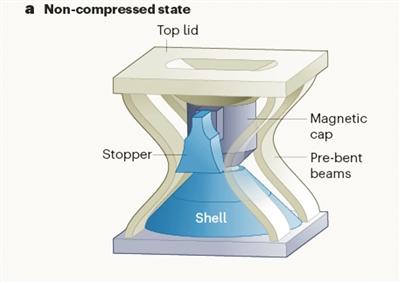Programmable mechanical metamaterials with stable memory come out
Helps develop new materials that directly process data and perform calculations
Partial schematic diagram of programmable metamaterials.
Image source: "Nature" online version
Science and Technology Daily, Beijing, April 19 (Reporter Zhang Mengran) What is a revolution in the material industry?
Programmable metamaterials should be counted among them.
According to a study published in the online edition of the British journal Nature, a team of Swiss scientists has developed a technology that can write, store and read data encoded in a mechanical form.
Just as hard disks have brought revolutionary changes to computer systems, this mechanically encoded metamaterial will enable flexible robots and engineering materials to enter a new stage of development, and will be widely used in fields that require remote modulation of device structural parameters.
Digital storage system is an indispensable part of computer.
The hard disk we are familiar with can be used to write and read the data stored in the magnetic poles, and the magnetic element is the base unit of the hard disk, and new data can be written by changing the value of the magnetic element through the electromechanical read-write head; the reverse is also possible Read the value of the magnetic element.
In such a system, data can be easily stored but not easily lost, even if the device is not powered on for several years, the data will not be lost.
Now, researchers from the School of Mechanical Engineering at the Federal Institute of Technology in Lausanne, Switzerland, have developed a mechanically encoded device based on this principle, but the bit is not a magnetic medium, but a non-steady-state shell that performs a clutch action. Quickly change the bending state, switch from one steady state to another steady state; at the same time, the mechanical bits arranged in a two-dimensional array can adjust the overall structural parameters of the device.
To put it simply, the new device developed this time is composed of mechanical bits, similar to the magnetic bits in a computer hard disk, but not only can it be easily written, stored for a long time, and read mechanically encoded data at any time. , And the information contained in the code can be used to adjust the device structure parameters.
This is a practical example in the field of metamaterials. The goal of storing and extracting non-volatile data with metamaterials has always been an "elusive" state.
This achievement has brought a noteworthy expansion to the metamaterial tool set, and has important application potential for engineering applications that need to control system rigidity and energy density during operation. At the same time, this achievement will enable ultra-low power consumption Style metamaterials bring new design solutions.
In the next step of the research, the team will convert the 36 bits of the system into a 3D structure and miniaturize and scale it.
The "Nature" article evaluates that this achievement is an early example of a metamaterial remote programmable device, opening a door to materials that directly process data, perform calculations, and learn in the future.
Editor-in-chief
Metamaterials are materials that do not exist in nature.
Humans have redesigned the geometric structure of materials, giving them some strange and even abnormal characteristics beyond imagination.
Their application can bring changes to many fields such as information technology, aerospace, energy, and spawn new industries.
The metamaterial mentioned in the article is a programmable material.
The so-called programmable is to follow a set of rules. By changing the "input", the "output" can be changed.
The functions of metamaterials can be reprogrammed as needed, which sounds even more "open minded".
This is still an early achievement, but it opens the way for more whimsical ideas in the future.

